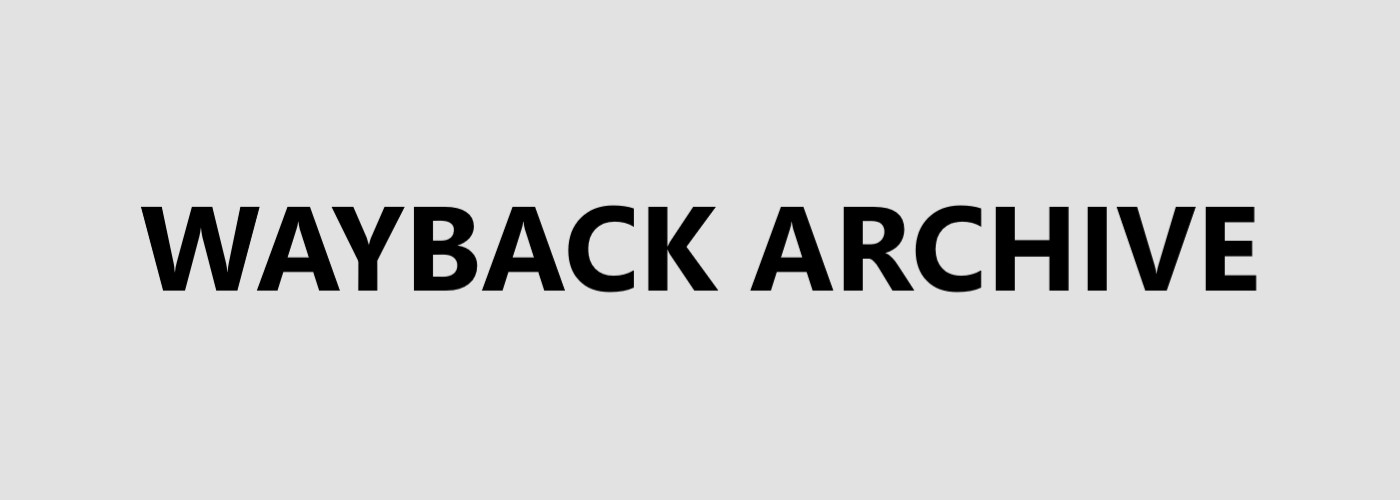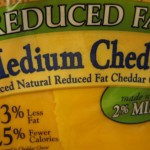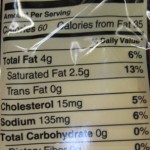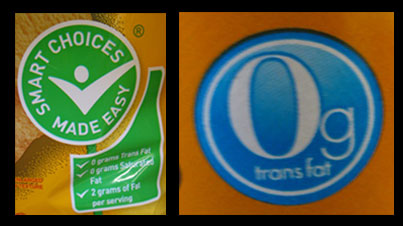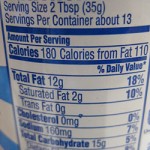Reading Nutritional Labels
It doesn’t matter if you want to gain muscle or lose fat, if you want to be successful you MUST learn to read nutritional labels. I get questions all the time asking me if this or that is a good food, in this section I will give you the knowledge to decide for yourself if a particular cereal or canned chili is good nutrition.
Our government does lots of incredibly stupid things so when it actually does something smart, its rather shocking. The NLEA (National Labeling and Education Act) of 1990 is one of the few smart things our government has done. Before 1990, it was really tough to tell if a food was healthy or not, now its really easy!
Before we start looking at labels, you need to know some important numbers for yourself. How many calories do you need in each meal and how many grams of protein do you need in each meal. If you are serious about adding muscle, you need to spread your protein intake evenly throughout the day – 6 meals.
The chart below gives you two very important nutritional numbers you need for each meal if you want to gain muscle and lose fat at the same time. This chart is a starting point. Depending on your age, activity level and metabolic rate you may need more or less food.
|
Current Weight
|
Calories
|
Protein
|
| 280lbs (127kg) | 610cals x 6 meals = 3700 cals | 46g x 6 meals= 280g protein |
| 260 lbs (118kg) | 560 cals x 6 meals = 3400 cals | 43g x 6 meals= 260g protein |
| 240 lbs (109kg) | 510 cals x 6 meals = 3100 cals | 40g x 6 meals= 240g protein |
| 220 lbs (100kg) | 460 cals x 6 meals = 2800 cals | 36g x 6 meals= 220g protein |
| 200 lbs (91kg) | 410 cals x 6 meals = 2500 cals | 33g x 6 meals= 200g protein |
| 180 lbs (81kg) | 360 cals x 6 meals = 2200 cals | 30g x 6 meals= 180g protein |
| 160 lbs (72kg) | 310 cals x 6 meals = 1900 cals | 26g x 6 meals= 160g protein |
| 140 lbs (63kg) | 265 cals x 6 meals = 1600 cals | 23g x 6 meals= 140g protein |
For example, a 180lb bodybuilder who wants to gain muscle and lose fat at the same time needs to eat 6 meals a day, each with 30g protein and 360 calories. So now the big question obviously is how to figure out how many calories and how much protein each meal you are eating has, that’s where nutritional labels come in. Whether you are trying to gain muscle or lose fat, you want to know the following three very important things about every meal you eat
- how much protein (needed to build muscle)
- how many calories (impt so don’t get fat)
- how much fiber (helps makes you feel full with fewer calories)
Lets look at a label and see where we can get this information.
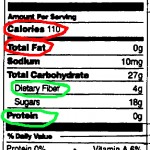 In the above label, the first important thing to notice is the serving size, in this case its the entire jar. In green we see two important numbers, the amount of protein and fiber. In this case their is no protein, not a very good food for a bodybuilder! The other green number circled is the fiber, fiber is great because it fills you up without adding calories. The top number circled in red is the number of calories, very important for us.
In the above label, the first important thing to notice is the serving size, in this case its the entire jar. In green we see two important numbers, the amount of protein and fiber. In this case their is no protein, not a very good food for a bodybuilder! The other green number circled is the fiber, fiber is great because it fills you up without adding calories. The top number circled in red is the number of calories, very important for us.
Choosing Ready-Made Meals
Now lets look at some possible meals. Lets say you are a 180lb bodybuilder and are trying to gain muscle and lose weight at the same time. As I mention in the bulking up section, it IS possible to add muscle and lose weight at the same time but is very difficult. Difficult only because your nutrition needs to be so strict, you will soon see why this is the case. From the chart above, we know that the meals for our hypothetical 180lb bodybuilder who wants to lose fat and gain muscle needs to have 30g protein and 360 calories. First lets see if one of the most popular fast food burgers makes a good meal. Is a Big Mac a good meal for this 180lb bodybuilder? Lets look at the at the nutritional label for a Big Mac:
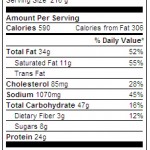 Hmmm. What do you think, is this a good meal??? Yikes, no way! Remember, the three things that are important when we are looking at labels – what are they? Protein, calories, and fiber. OK, protein we need 30g -how many are here? Only 24, not enough protein. OK, what’s next – calories. We want our meal to have no more than 360 calories and what have we here? Jimmeny Cricket a whopping 590 calories, almost twice our allotment. The last thing, fiber, how much – a measly 3grams. Not only will the Big Mac starve your muscles of the protein they need to rebuild but the excess calories will plop itself right on top of your belly.
Hmmm. What do you think, is this a good meal??? Yikes, no way! Remember, the three things that are important when we are looking at labels – what are they? Protein, calories, and fiber. OK, protein we need 30g -how many are here? Only 24, not enough protein. OK, what’s next – calories. We want our meal to have no more than 360 calories and what have we here? Jimmeny Cricket a whopping 590 calories, almost twice our allotment. The last thing, fiber, how much – a measly 3grams. Not only will the Big Mac starve your muscles of the protein they need to rebuild but the excess calories will plop itself right on top of your belly.
The big problem with fast food is the high fat content, we see that this burger is 52% fat! OK, now that we have seen that we need to be a little more careful than that lets choose something better. Lets say that we are really busy and don’t have time to cook but we want something tasty and bodybuilder friendly so we walk down the freezer isle at the store and look at the store. Here is an example of one of those “healthy choice” type of frozen dinners, is this a good meal for our 180 pound bodybuilder???
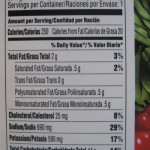 OK, first question, how much protein is there? Our hypothetical 180 pound bodybuilder needs 30g protein and we see there is … 15g hmmmm that’s only half what we need so he would need to eat two of these dinners to get enough protein. Well, what about calories, we want no more than 360 cals and how many are here? …. 250 calories but we are eating two of these frozen dinners so that’s 500 calories which is 140more calories than we want. Yikes, you see how difficult this is. If you want to get enough protein to gain muscle but want to lose fat you need to be very, very careful about what you eat. This frozen dinner is one of the really healthy, low fat ones and it still wont work for us. Ok, lets keep shopping – why don’t we try the canned food aisle. Lets try chili, here is a low fat chicken chili lets look at its label:
OK, first question, how much protein is there? Our hypothetical 180 pound bodybuilder needs 30g protein and we see there is … 15g hmmmm that’s only half what we need so he would need to eat two of these dinners to get enough protein. Well, what about calories, we want no more than 360 cals and how many are here? …. 250 calories but we are eating two of these frozen dinners so that’s 500 calories which is 140more calories than we want. Yikes, you see how difficult this is. If you want to get enough protein to gain muscle but want to lose fat you need to be very, very careful about what you eat. This frozen dinner is one of the really healthy, low fat ones and it still wont work for us. Ok, lets keep shopping – why don’t we try the canned food aisle. Lets try chili, here is a low fat chicken chili lets look at its label:
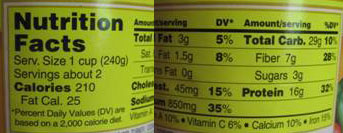 OK, how about this can of chili. Is it a good meal??? What’s the first question? Protein. We need 30g, how many in this can? Lets see each serving has 16g and there are 2 servings so there is 32g protein in the can so we need to eat the whole can to get enough protein. OK, now how many calories are there in the can? We want to eat less than 360 calories. There are 210 calories per serving and we are eating two servings so that is 420 calories. Geeze, this is tough! This can of chili is pretty close but still to get our 30g protein we are eating 80 more calories than we should.
OK, how about this can of chili. Is it a good meal??? What’s the first question? Protein. We need 30g, how many in this can? Lets see each serving has 16g and there are 2 servings so there is 32g protein in the can so we need to eat the whole can to get enough protein. OK, now how many calories are there in the can? We want to eat less than 360 calories. There are 210 calories per serving and we are eating two servings so that is 420 calories. Geeze, this is tough! This can of chili is pretty close but still to get our 30g protein we are eating 80 more calories than we should.
Cook Your Own Meal
Now you are beginning to see why many people claim that its not possible to lose fat and add muscle at the same time, it’s because there is no ready-to-eat food that you can buy which meets our requirements. You either need to cook your own meals, or eat the prepared meals and increase your daily cardio from 30min/day to 90min/day or more to burn off the excess calories. It looks like we are going to have to do this the old fashioned way and cook our own meals if we want to lose fat and gain muscle at the same time. Lets start with the protein. When planning our meal, we start with the protein source which needs to be a very lean (nonfat) form of protein.
- 3.6 oz boneless, skinless chicken brest broiled (not fried) – 190 calories 30g protein
We have used up 190 of our 360 calories for the protein source, note that this does not allow for any sauces or condoments. We have 170 calories remaining in our 360 calorie meal, lets make the most of them. We want lots of fiber and vitamins. Lets add some complex carbs to give us energy and fiber, how about brown rice. Lets use about 100cal on the rice
- 3 ounces brown rice, 100 calories
Now we have used 270 of the 360 calories allowed for this meal. So far our meal is pretty sparse, if that’s all we had to eat we’d be pretty hungry afterward. What we need is something that has lots of fiber to fill us up but not many calories – this is where vegetables shine! Vegetables are the key to good nutrition, not only because they have lots of vitamins but because they have lots of fiber that fills you up with hardly any calories. We have 70 calories left in our 360 calorie meal, we could have:
- 1.5 cups cut carrots
- or 2 cups cooked cabbage
- or 3 cups string beans
- or 5 cups of chopped celery – wow, that’s a gut buster!
So our final meal for our hypothetical 180 pound bodybuilder who wants to gain muscle and lose fat is as follows:
- 3.6 ounce boneless, skinless chicken
- 3oz cooked brown rice
- 3 cups green beans
And this meal has 360 calories with 30g protein. So now you see how much work bodybuilding can be. You can also see why many people get the mistaken notion that you have to bulk up (get fat) to gain muscle, its because its so tough to get enough protein without eating too many calories. You can lose fat and gain muscle at the same time but its really a difficult and time consuming nutritional task.
Labeling Tricks
Now lets look at some tricks that companies play with their labels so you don’t fall for them. The oldest trick in the book is to fool you into thinking that a food is healthier than it is. Lets look at the law:
“A list of the ingredients must be included on all foods that have more than one ingredient. Ingredients must be listed in descending order of predominance and in defined terminology. Ingredients that are present in amounts of less than 2 percent of the product do not necessarily need to appear in order of predominance. “
Lets say you are the maker of a sugary kids breakfast cereal that is 75% sugar and 25% flour, its ingredients list by law would have to look like this:
Ingredients: sugar, whole wheat flour
Who would buy their kids cereal where sugar wast the FIRST ingredient? Not many. So how can our sneaky manufacturer keep the cereal 75% sugar but have the flour be the first ingredient? Aha! Instead of using 75% sugar, use 25% honey, 25% sugar, and 25% high fructose corn syrup. Now, the same sugary cereal can legally list their ingredients as:
Ingredients: whole wheat flour, honey, sugar, high fructose corn syrup
That ceral formulation looks much healthier to parents.
Labeling Trick – “Reduced Fat”
Now lets look at some other tricks, the meaningless claims. By far the worst one is the “reduced fat” claim, doesn’t that sound healthy? Certainly does, but it can be very unhealthy! Lets look at a reduced fat product:
This reduced fat cheese claims “33% less fat”, well when you start with a product that is almost 100% fat like many dairy products are, that claim is not very significant. From its nutritional label, we see that 35 of this cheeses 60 calories are from fat, that means that although this cheese is “reduced fat”, it is still 58% fat! Not allowed in our diets!
Labeling Trick – “0g trans fat”
Another trick is the meaningless “0 grams trans-fat” claim:
They stick these labels on making people think they are healthy and many people get confused and think there is “0g fat” which is not true at all. Many of the products with these monikers are snack foods which are actually extremely high in fat. What you need to shop for if you are concerned about health is nonfat products. A nonfat product by definition will not only have 0g trans fat but will also be low in calories.
The Disappearing Fat Trick
Lets look at the meanest labeling trick, the disappearing fat trick. Here is the law:
“Products containing less than 5g of fat show amounts rounded to the nearest .5g. Amounts less than .5g are rounded to 0g.”
That rule applies to one portion. All manufacturers have to do is to choose a small enough portion size so that the amount of fat per portion is less than .5g and then they can claim it has no fat even if it is 100% fat. An example of this would be a non-dairy creamer. Non-dairy coffee creamers are basically just hydrogenated palm oil – talk about unhealthy! Because the portion size is so small, they can claim 0g fat even though people like me who like their coffee really white would use ten of their skimpy portions in a single cup of coffee and thus get 5g fat (45 calories) of the most deadly, heart-clogging fat known to mankind.
Quiz
Lets recap with a quick quiz. You are a 160lb bodybuilder and want to gain muscle and lose fat. You are contemplating having one of your meals be 6 tablespoons of the reduced fat peanut butter shown below:
Here is the quiz:
- 1) How many calories should be in each of your 6 meals?
- 2) How many grams protein should be in each of your 6 meals?
- 3) How many calories does the 6 tbsp of peanut butter have?
- 4) How much protein does the 6 tbsp of peanut butter have?
- 5) Does this reduced fat peanut butter make a good meal?
Here are the answers, did you get them all right?
Some Nutritional References
Here is a great website to find nutritional information on products:
http://www.nutritiondata.com
Labeling laws:
http://www.fda.gov/ora/inspect_ref/igs/nleatxt.html
